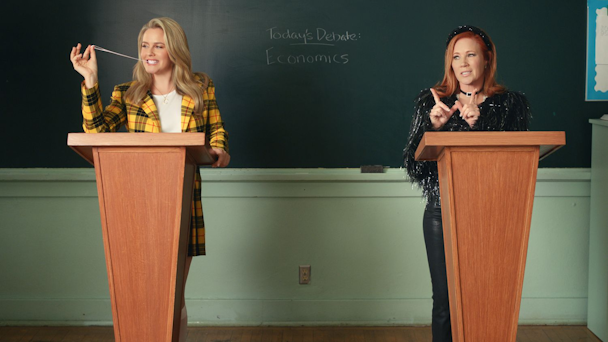How brands – and capitalism – killed nostalgia
Remember when remembering was less tiresome and when nostalgia carried more weight? Cultural strategist Molly Barth certainly does. Here’s where it all went wrong.

Following on from Dan Cullen-Shute’s Doctor Whovian take on nostalgic regeneration, I think we all feel stuck in a time loop. From mainstream media to big brands and advertisers, lately, it seems like everyone’s reaching for the lowest common denominator by way of nostalgia; be it consumers for comfort or brands for profits.
We’ve reached peak nostalgia, and it’s not hard to see why. The past few years haven’t been great, and the future isn’t looking much better. A survey of young people 16 to 25 found that three-quarters were frightened of the future.
“We remain trapped in the twentieth century,” claimed theorist Mark Fisher. Fisher’s formative insight was that in capitalist societies, as technology advances and consumerism infiltrates almost every part of our lives, our culture deteriorates, and we increasingly lose our sense of time and progress. The unfortunate result is a somewhat boring cultural landscape that becomes much more derivative than the original. We’ve gotten stuck in a kind of insipid, amnesiac cycle, unable to imagine anything new.
Younger generations, in particular, seem trapped in a state of arrested development. Unable to reach traditional milestones (like purchasing a house, finding a job, or getting married), what feels good is thinking about the past when things were simpler.
Advertisement
Brands have jumped on this consumer demand for nostalgic content, and in many ways, it has proven successful (Walmart’s Mean Girls Black Friday spot is a great example). But brands’ increasing reliance on nostalgia for an easy emotional connection dilutes its true essence. The relentless pursuit of profit and performance has led to a commodification of nostalgia that risks eroding the genuine emotional connections we have with the past. This year’s Super Bowl ads proved as much – from Rakuten’s Alicia Silverstone 'Clueless' revival to T-Mobile’s Grease-inspired singalong.
But why would brands act any differently? So far, research has proven the effectiveness of nostalgia as a marketing strategy, serving as a comforting emotional salve that can temporarily mask the normal anxiety that would inhibit impulsive or excessive spending.
Nostalgia has seen great success in the media landscape as well. Familiar content resonates with audiences and is profitable for increasingly risk-averse studios. Screenrant’s forty “most anticipated films” of 2023 can be broken down into the following categories: 17 sequels, eight reboots and remakes, and four spin-offs. Just three are based on new original material. By comparison, in the 1980’s, 40–75% of all films were based on “original content.”
Advertisement
But it’s reaching a point of uninspired exhaustion. Call it “sequelitis” or “fratigue” (franchise fatigue). For every ‘Squid Games’ or ‘Everything Everywhere All At Once,’ it seems like ten times the amount of content rooted in upcycled IP and pre-existing fandoms. While there is a time and place for comforting content, there’s still an appetite for diverse and dynamic storytelling. Right?
Nostalgia has reached a fever pitch in fashion, too. An article recently published in Dazed muses, “Why have people looked the same for the last 20 years?”. Rapid trend cycles on TikTok have created an infinite number of subcultures and corresponding styles, making it infinitely harder to keep up with the latest trends. What used to be a style that could mark a particular year or decade now quickly becomes popularized and then oversaturated within a week.
In comparison, the 20th century was a period of rapid growth and consumerism, with huge changes in policy, architecture, art, fashion and culture. The ’60s, ’70s and ’80s had such distinct aesthetics one could watch a film or look at an article of clothing and easily deduce which decade it belonged to. Could the same be said for the past 20 years?
On social, there are copious amounts of nostalgia for past decades, but also, more specifically for what the internet used to stand for – connection, socialization, weirdness, fun. People have been drawn towards nostalgic relics of the “old” digital world – see what the internet looked like ten years ago, browse an internet artifact museum, or resurrect Y2K Myspace aesthetics. With many people predicting the inevitable demise of traditional social media, it seems the obsession with nostalgic content online indicates a larger feeling that the internet, and by extension, modern culture, is no longer serving people.
What’s to come? The New York Times asked 46 artists, filmmakers, chefs and other creative people to forecast next year’s cultural trends, and there was a clear nostalgic throughline. “Back to the ’80s again,” said writer and museum director Franklin Sirmans. “Donna Karan’s ’80s look. Power suits,” said Alex Eagle, creative director. “The ’90s (though in my mind they’ve never gone away),” said Sharon Van Ette, singer-songwriter. “There’s such a nostalgia for the late ’70s/early ’80s in design,” concluded Jenna Lyons, designer. Seems like what’s to come is a lot of the same.
Suggested newsletters for you
With so much tepid nostalgia recycling, is our culture today unique enough that future generations will have any nostalgia for it? There’s evidence that nostalgia itself is becoming warped. For some, it’s a trauma-induced nostalgia for the pandemic. For many Gen Z, it takes the form of nostalgia for when they weren’t even alive (or sentient). Nostalgia seems to be collapsing in on itself.
Our obsession with the past goes against every self-help epithet – “don’t look back, you’re not going there”... “the only way forward is through.” There is power in the past, yes, but can’t brands help us to build a more positive present (and better yet, future)? Nostalgia is an inextricable component of culture-making, but gone unchecked, we risk trapping ourselves in a time loop. The past can actually help shape our future – so long as we don’t let ourselves get stuck in it.
Here’s Molly's LinkedIn if you want to continue the discussion.

